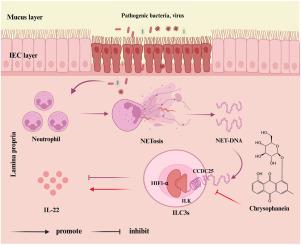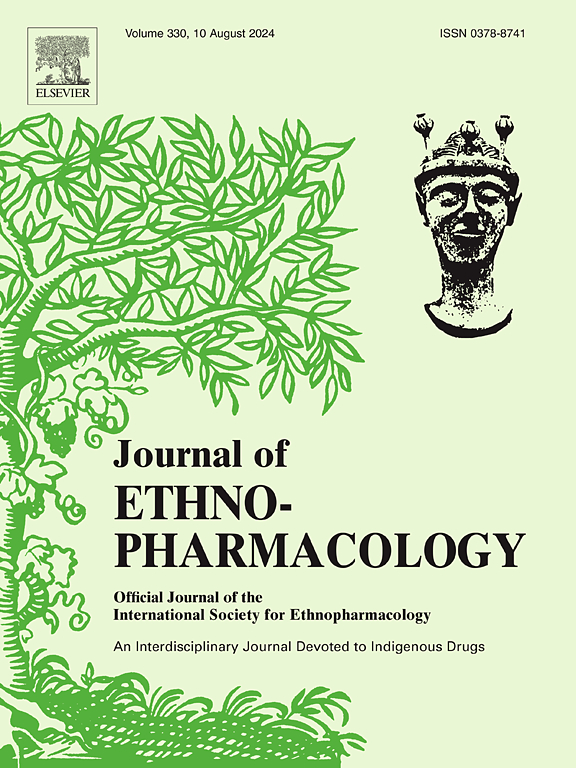Chrysophanein of Rhubarb rescues ILC3-Derived IL-22 by blocking CCDC25/ILK/HIF-1α for mucosal healing in ulcerative colitis mice
IF 5.4
2区 医学
Q1 CHEMISTRY, MEDICINAL
引用次数: 0
Abstract
Ethnopharmacological relevance
In traditional Chinese medicine, rhei radix et rhizoma, is derived from the dried roots and rhizomes of Rheum palmatum L., Rheum tanguticum Maxim. ex Balf. or medicinal Rheum officinale Baill, are used to treat intestinal carbuncle and abdominal pain, as well as damp-heat dysentery. Chrysophanein is a natural compound extracted from rhei radix et rhizoma with significant anti-inflammatory properties.
Aim
Ulcerative colitis (UC) is characterized by chronic mucosal inflammation. Current therapies alleviate symptoms via anti-inflammatory effects but fail to prevent relapse. Restoring the intestinal mucosal barrier represents a novel therapeutic strategy beyond conventional approaches. This study aims to show that chrysophanein ameliorates UC symptoms by targeting the coiled-coil domain containing protein 25/integrin-linked kinase/hypoxia-inducible factor-1α(CCDC25/ILK/HIF-α) pathway to repair mucosal barrier integrity.
Methods
We established a CCDC25-overexpressing UC mouse model through the intraperitoneal injection of adeno-associated virus (AAV)-CCDC25, alongside providing the mice with free access to dextran sulfate sodium(DSS). Disease progression was evaluated through body weight, survival status, colon length, endoscopy, and histopathology. chrysophanein-treated UC mice were assessed via Alcian blue staining (mucin quantification), WB (Occludin/ZO-1/claudin-1), in vivo imaging (FITC-dextran 4000 distribution), limulus amebocyte lysate assay (serum LPS), bacterial translocation assays, WB (CCDC25/ILK/HIF-1α pathway), and flow cytometry (IL-22+ILC3s). Transmission electron microscopy (TEM) evaluated epithelial morphology, and co-culture experiments examined chrysophanein's protective effects on enterocytes.
Results
Compared to control AAV-UC mice, CCDC25-overexpressing mice exhibited exacerbated symptoms. chrysophanein significantly attenuated weight loss, hematochezia, and colon damage, enhanced mucosal barrier function (mucin, ZO-1/Occludin/Claudin-1), reduced bacterial translocation and serum LPS, suppressed CCDC25/ILK/HIF-1α, and elevated IL-22+ILC3 proportions in UC mice. However, CCDC25 overexpression diminished chrysophanein's efficacy, correlating with reduced IL-22+ILC3s. chrysophanein-MNK3-conditioned media increased TEER, lowered FD4 permeability, and upregulated ZO-1 (mimicking IL-22 recombinant protein), whereas OECCDC25-MNK3 media reversed these effects, confirming CCDC25's overexpression interferes with chrysophanein-mediated intestinal epithelial barrier repair via the IL-22 pathway.
Conclusion
Chrysophanein rescues ILC3-derived IL-22 by blocking CCDC25/ILK/HIF-1α for mucosal healing in UC.

大黄大黄素通过阻断CCDC25/ILK/HIF-1α对溃疡性结肠炎小鼠粘膜愈合的IL-22的修复作用
民族药理学相关性:在中医中,大黄(rhei radix et rhizoma)是由大黄(Rheum palmatum L.)、大黄(Rheum tanguticum Maxim)的干燥根和根茎衍生而来。Balf交货。或药用大黄,用于治疗肠道痈和腹痛,以及湿热痢疾。大黄素是从大黄根茎中提取的天然化合物,具有显著的抗炎特性。目的:溃疡性结肠炎(UC)以慢性黏膜炎症为特征。目前的治疗方法通过抗炎作用缓解症状,但不能防止复发。恢复肠黏膜屏障是一种超越传统方法的新型治疗策略。本研究旨在证明大黄蛋白通过靶向含有25/整合素连接激酶/缺氧诱导因子-1α(CCDC25/ILK/HIF-α)通路的线圈结构域修复粘膜屏障完整性来改善UC症状。方法:通过腹腔注射腺相关病毒(adeno-associated virus, AAV)-CCDC25,建立过表达ccdc25的UC小鼠模型,并使小鼠自由进入DSS。通过体重、生存状态、结肠长度、内窥镜检查和组织病理学来评估疾病进展。通过阿利新蓝染色(粘蛋白定量)、WB (Occludin/ZO-1/claudin-1)、体内成像(fitc -葡聚糖4000分布)、鲎试剂裂解液测定(血清LPS)、细菌易位测定、WB (CCDC25/ILK/HIF-1α途径)和流式细胞术(IL-22+ILC3s)对大黄苷处理的UC小鼠进行评估。透射电子显微镜(TEM)评估上皮形态,共培养实验检查大黄蛋白对肠细胞的保护作用。结果:与对照AAV-UC小鼠相比,ccdc25过表达小鼠表现出加重的症状。大黄苷显著减轻UC小鼠的体重减轻、便血和结肠损伤,增强粘膜屏障功能(粘蛋白、ZO-1/Occludin/Claudin-1),减少细菌易位和血清LPS,抑制CCDC25/ILK/HIF-1α,提高IL-22+ILC3比例。然而,CCDC25过表达降低了大黄素的疗效,与IL-22+ ilc3的降低有关。大黄素- mnk3培养基增加了TEER,降低了FD4通透性,上调了ZO-1(模拟IL-22重组蛋白),而OECCDC25-MNK3培养基逆转了这些作用,证实了CCDC25过表达通过IL-22途径干扰大黄素介导的肠上皮屏障修复。结论:大黄花素通过阻断CCDC25/ILK/HIF-1α促进UC粘膜愈合,从而恢复ilc3来源的IL-22。
本文章由计算机程序翻译,如有差异,请以英文原文为准。
求助全文
约1分钟内获得全文
求助全文
来源期刊

Journal of ethnopharmacology
医学-全科医学与补充医学
CiteScore
10.30
自引率
5.60%
发文量
967
审稿时长
77 days
期刊介绍:
The Journal of Ethnopharmacology is dedicated to the exchange of information and understandings about people''s use of plants, fungi, animals, microorganisms and minerals and their biological and pharmacological effects based on the principles established through international conventions. Early people confronted with illness and disease, discovered a wealth of useful therapeutic agents in the plant and animal kingdoms. The empirical knowledge of these medicinal substances and their toxic potential was passed on by oral tradition and sometimes recorded in herbals and other texts on materia medica. Many valuable drugs of today (e.g., atropine, ephedrine, tubocurarine, digoxin, reserpine) came into use through the study of indigenous remedies. Chemists continue to use plant-derived drugs (e.g., morphine, taxol, physostigmine, quinidine, emetine) as prototypes in their attempts to develop more effective and less toxic medicinals.
 求助内容:
求助内容: 应助结果提醒方式:
应助结果提醒方式:


